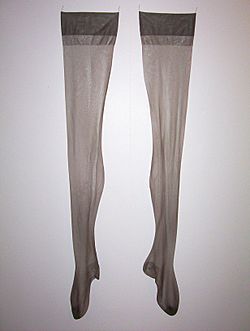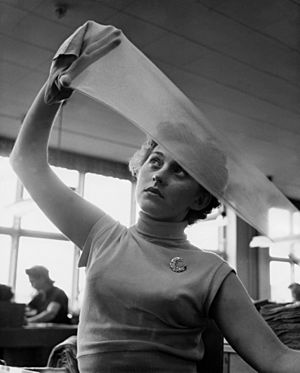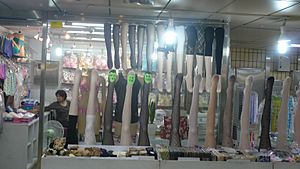Stocking facts for kids

A pair of dark grey nylon stockings.
|
|
| Material | silk or rayon |
|---|---|
Stockings are close-fitting clothes that cover your leg. They go from your foot up to your knee or even your whole thigh. Stockings come in many colors, designs, and levels of see-through (transparency). Today, people mostly wear stockings for fashion and style. They are often worn with skirts that are mid-length or short.
Contents
The History of Stockings
Long ago, what men wore on their legs were often called stockings, especially if they were long. The word "stock" used to mean the lower part of the body. So, it was used for the leg coverings people wore in the 1400s. These were like tights, with an "upper-stock" (which later became knee breeches) and "nether-stocks" (which became stockings).
Before the 1590s, stockings were made from woven cloth. The first machines for knitting were made to create stockings. These early stockings were made from materials like cotton, linen, wool, or silk. A smooth, shiny cotton called lisle was very common.
Before the 1920s, people wore stockings mainly to keep warm. Women, especially in pioneer times, wore long underwear under their long dresses. In the 1920s, dress hemlines (the bottom edge of a dress) became shorter. Also, churches were not heated well. So, women started wearing sheer, flesh-colored stockings over their long underwear. This helped cover their exposed legs. These stockings were first made of silk or rayon. After 1940, they were made of nylon.
Nylon Stockings Become Popular
In 1939, a company called DuPont introduced nylon. This caused a huge demand for stockings in the United States. On one day, people bought up to 4 million pairs! Nylon stockings were popular because they were cheap, strong, and sheer. This was much better than cotton and silk stockings.
When America joined World War II, DuPont stopped making nylon stockings. Instead, their factories made things for the war, like parachutes and ropes. This led to a big shortage of stockings. People tried to find them wherever they could, sometimes even buying them illegally.
After the war, DuPont announced they would make stockings again. But they couldn't make enough to meet the demand. This led to people getting very upset in American stores. These events were called the "nylon riots." DuPont eventually increased production to meet everyone's needs.
From Stockings to Pantyhose
In the 1940s and 1950s, a type of early pantyhose appeared. Actresses and dancers in movies and plays had stockings sewn to their briefs. This was seen in popular films like Daddy Long Legs.
Today, stockings are often made from knitted wool, silk, cotton, or nylon. In 1959, commercial pantyhose were introduced. They offered an easier alternative to stockings. Because of this, the use of stockings went down a lot. A big reason was the trend for dresses to have higher hemlines, like the minidress.
In 1970, sales of pantyhose in the U.S. were higher than stockings for the first time. This trend has continued ever since. Starting in 1987, pantyhose sales began to drop slightly. This was due to new "hold-ups" (stockings that stay up by themselves). However, pantyhose are still the most sold type of leg covering.
Why Choose Stockings?
Some people still prefer stockings over pantyhose for several reasons. They might feel that stockings, especially with garter belts or lace, look more stylish.
Both nylon stockings and pantyhose are sheer. This means they dry quickly compared to pants. It's also easy to carry extra pairs if one gets damaged. If a stocking gets a run (a ladder), you can replace just one. This can save money compared to replacing a whole pair of tights.
However, stockings have a downside in cold weather. More skin is exposed to the cold compared to pantyhose. Also, pantyhose do not need garter belts. They also don't need to be adjusted as much. Plus, they create a smoother look under clothes that fit tightly.
How Stockings Stay Up
Stockings can be held up in three main ways:
- A garter belt (also called a suspender belt in British English) is the most common way. It's a piece of underwear worn around the waist, under your clothes. It has straps that clip to the tops of the stockings.
- Stay-ups (or hold-ups) are the second most common way. The top inside edge of these stockings has a sticky band, usually made of silicone. This band helps the stocking stay up on your thigh. However, they don't always fit every thigh size perfectly. They might slip down or be too tight, which can be uncomfortable.
- A garter is the least common way. It's a band slipped over the top of the stocking. It holds the stocking by gently squeezing it to your leg. These are the garters often worn by a bride at her wedding. They can have similar comfort issues as stay-ups.
Stocking Words to Know
In modern language, "stocking" usually means two separate pieces, one for each leg. (But in American and Australian English, it can sometimes mean pantyhose too). "Hold-ups" and "thigh highs" are stockings that stay up with built-in elastic. The general term "stockings" often refers to those that need a garter belt. They are different from tights or pantyhose.
Here are some other terms used with stockings:
- Denier: This number tells you how sheer (see-through) a stocking is. A lower denier means it's more sheer. A higher denier means it's less sheer but usually stronger.
- Fishnet: These are stockings with a very wide, open knit pattern, like a fishing net.
- Fully Fashioned: These stockings were knitted flat. Then, the material was cut and sewn together with a seam up the back. This was the most popular style until the 1960s.
- Knee highs: Stockings that end at or just below the knee. They are also called half-stockings or trouser socks.
- Matte: Stockings that have a dull or non-shiny finish.
- Mock seam: A fake seam sewn into the back of a seamless stocking for a certain look.
- Opaque: Stockings made with thicker yarn, giving them a heavier, less sheer look (usually 40 denier or more).
- Seamless: Stockings made in one continuous process on circular machines. This means they don't have a seam up the back.
- Sheers: Stockings that are very thin and see-through, usually 15 to 20 denier.
- Ultra sheer: An extremely fine fiber that gives the most see-through look. Usually 10 denier.
- Welt: A piece of fabric knitted separately and sewn to the top of a stocking. It's made with thicker yarn and folded to give strength for attaching to a garter belt.
Images for kids
See also
 In Spanish: Medias para niños
In Spanish: Medias para niños








